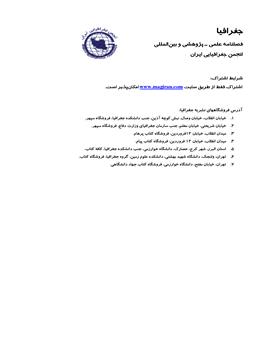Evaluation of Urban Smart Growth Indicators Using Factor Analysis Model (Case Study: District 1, Shiraz, Iran)
Subject Areas :Mohammad 1 , 2 , 3
1 -
2 -
3 -
Keywords: smart growth sustainable development compact city factor analysis, Shiraz city,
Abstract :
The Smart Growth Strategy is one of the new approaches to sustainable development. The present study is based on a descriptive-analytic method using a questionnaire, where the reliability of the research tool was obtained based on the Cronbach's alpha coefficient as 0.82. The statistical sample involved 321 citizens of District 1 of Shiraz. The data were analyzed using SPSS software. To achieve the research objective (determining the status of Smart growth indicators in District 1 of Shiraz(, a factor analysis test was used. The results of Bartlett's test of sphericity showed that there was a significant relationship between the urban Smart growth indexes studied in the study (with 0.000Sig), in fact, there was a significant correlation between variables. in the Criterion of the four factors density, "net residential density" with the factor load of 0.760, "public transport access or walking to work" with factor load of 0.820 and " using public transportation or walking to access the CBD” with: 0.790 were identified as the most important factors. Moreover, in the factor accessibility criteria, "rate of apartment living" with the factor load of 0.821, "ease of access to public transportation" with factor load of 0.570 and "rate of using public transport or walking for access to CBD", 0.539 were identified as the most important factors. Finally, in the field of mixed land use, “percentage of households in residential units”, "walking or public transportation access rate to recreational facilities" and "ease of access to public transportation" were identified as the most important factors.
1. بخشی، امیر؛ دیوسالار، اسدالله؛ علی¬اکبری، اسماعیل (1394)، «تحلیل فضای شاخص رشد هوشمند شهری در شهرهای ساحلی مطالعه موردی: بابلسر»، فصلنامه مدیریت شهری، شماره 33؛
2. بزرگمهر، نسیم؛ حبیبی، میترا و برک¬پور، ناصر (1390)، «ارزیابی طرح پیشنهادی توسعه شهر کرج مبتنی بر رویکرد رشد هوشمند»، فصلنامه دانشگاه هنر، شماره11؛
3. بشیری، لیلی؛ حقیقت نایینی، غلامرضا و حبیبی، میترا (1390)، «ارائه الگوی تعیین تراکم مسکونی در منطقه 22تهران با استفاده از اصول رشد هوشمند شهری»، فصلنامه دانشگاه هنر، شماره9؛
4. حسینی، سیدعلی؛ ویسی، رضا و احمدی سجاد (1391)، «بررسی و تحلیل فضاي سبز شهر شیراز، دوفصلنامه پژوهش-هاي بوم¬شناسی شهری»، سال سوم، شماره 1؛
5. رحیمی، محمد (1396)، «تجارب توانمندسازی سکونتگاههای غیررسمی ایران و جهان، با تاکید بر روش¬های جلب مشارکت مردمی و تامین منابع مالی»، انتشارات آذرخش، تهران؛
6. زبردست، اسفندیار(1393)، «کاربرد مدل FANP در شهرسازی»، نشریه هنرهای زیبا، 23-3؛
7. زبردست، اسفندیار؛ خلیلی، احمد و دهقانی، مصطفی (1391)، «کاربرد روش تحلیل عاملی در شناسایی بافتهای فرسوده شهری»؛
8. سیف¬الدینی، فرانک و همکاران (1392)، « بسترهاو چالش¬هاي اعمال سیاست رشد هوشمندشهري، نمونه موردی: خرم-آباد لرستان»، فصل¬نامه جغرافیا و برنامه¬ریزي شهري چشم¬انداز زاگرس، سال ششم، شماره 19؛
9. شاهرخیان، علیرضا (1396)، «سالنامه آماری شیراز»، معاونت برنامه¬ریزی و توسعه سرمایه انسانی شهرداری شیراز، انتشارات فرهنگ پارس؛
10. صرافي، مظفر (1379)، «شهر پايدار چيست»، فصلنامه مديريت شهري، شماره 4؛
11. عزيز پور، ملكه و نجمه اسمعيل¬پور (1388)، «رشد افقي سريع شهر يزد و تاثير آن بر سفرهاي شهري در محدوده مركز و پيرامون اين شهر»، نشريه جغرافيا و برنامه¬ريزي، شماره 34؛
12. فردوسی، سجاد؛ شکری فیروزجاه، پری (1394)، «تحلیل فضایی -کالبدی نواحی شهری براساس شاخص¬های رشد هوشمند»، نشریه پژوهش و برنامه¬ریزی شهری سال ششم، شماره 23؛
13. مهندسین مشاور شهرسازی فرنهاد (1388)، «طرح تفصیلی منطقه یک شهرداری شیراز»؛
14. نشریه هنرهای زیبا،2: 27-4؛
15. Alexander, D. And Tomalty, R (2002), "Smart Growth And Sustainable Development: Challenges, Solutions, And Policy Directions" Local Environment, 7(4), 397-409;
16. Chrysochoou. M. (2012), "A GIS And Indexing Scheme To Screen Brownfields For Area-Wide Redevelopment Planning". Landscape And Urban Planning, 105, 187–198;
17. Couch C, Leontid0u L and Petschel-Held G (2007),"Urban Sprawl In Europe: Landscape "Landuse Change And Policy, Blackwell, U;
18. Daniels T (2005)," Land Preservation: An Essential Ingredient In Smart Growth" Journal Of Planning Literature, 19(3),316-32;
19. Downs, Anthony (2001), “What Does 'Smart Growth- Really Mean?” Planning (April), Http://Www.Planning.Org/Pubs/Plng01/April012.Htm;
20. Eugene (2000) City Of (2000), “Growth Management Implementation Projects”Status Report For 2000, Eugene, Oregon;
21. Hawkins V (2011), "Smart Growth Policy Choice: A Resource Dependency And Local Governance Explanation," The Policy Studies Journal, 39(4), 682-697;
22. Handy S (2005), "Smart Growth and the Transportation-Land Use Connection: What Does the Research Tell Us?" International Regional Science;
23. La Greca, P., L. Barbarossa, M. Ignaccolo, G Inturri, and F. Martinico. (2011), “The Density Dilemma, A Proposal For Introducing Smart Growth Principles In A Sprawling Settlement With In Catania Metropolitan Area, Cities 28”;
24. Staley, Samuel. R (2004), “Urban Planning, Smart Growth, and Economic Calculation: An Austrian Critique and Extension”. The Review of Austrian Economics, June 2004, Volume 17.


